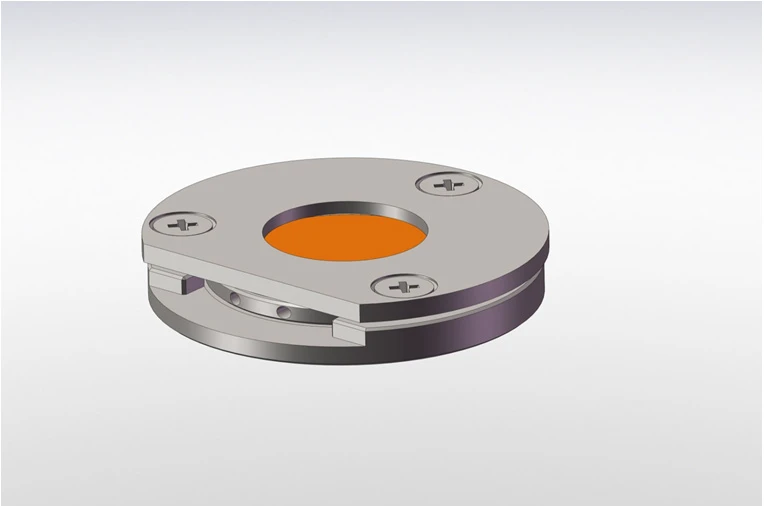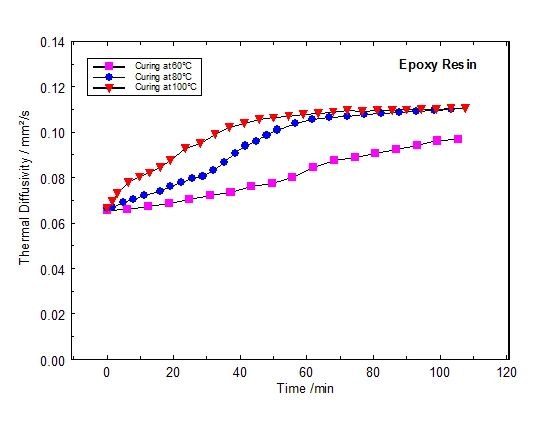In this work, the tests were carried out during Curing (Crosslinking Reactions)Literally translated, the term “crosslinking“ means “cross networking”. In the chemical context, it is used for reactions in which molecules are linked together by introducing covalent bonds and forming three-dimensional networks.curing at 60ºC, 80ºC and 100ºC. At each temperature, a series of tests was performed for a period of approximately 110 minutes (representing the typical production times). This special temperature program was selected to follow the typical Curing (Crosslinking Reactions)Literally translated, the term “crosslinking“ means “cross networking”. In the chemical context, it is used for reactions in which molecules are linked together by introducing covalent bonds and forming three-dimensional networks.curing process range in a production plant. The tests were carried out by preheating the sample holder stage of the instrument to the selected temperature. Then, the sample was inserted and the tests were started immediately. To measure a sample which is liquid at the beginning of the tests, a special sample holder is required, keeping the sample in the required position and shape inside the flash system. This sample holder is depicted in figure 1.

It consists of two metal orifices, separated by a PEEK ring with a well-defined thickness. Between the orifices and a distance ring, a thin sheet metal plate is brought in. The entire setup generates a tight volume inside the sample holder with welldefined dimensions. The PEEK ring has two holes for filling in the liquid material. The second hole allows the gas leaving the system during the filling process. Therefore, a highly viscous liquid can be filled in without the risk of generating bubbles inside the holder. The two holes are closed, after the sample holder is completely filled. The entire setup was then placed inside the flash system to carry out the tests. After the tests, the system can be disassembled and the cured resin disk can be taken out for final inspection or for further analysis.
Measurement Results
Figure 2 presents the values of the Thermal DiffusivityThermal diffusivity (a with the unit mm2/s) is a material-specific property for characterizing unsteady heat conduction. This value describes how quickly a material reacts to a change in temperature.thermal diffusivity of the resin versus time at Curing (Crosslinking Reactions)Literally translated, the term “crosslinking“ means “cross networking”. In the chemical context, it is used for reactions in which molecules are linked together by introducing covalent bonds and forming three-dimensional networks.curing temperatures of 60°C, 80°C and 100°C. As can be seen in this figure, the Thermal DiffusivityThermal diffusivity (a with the unit mm2/s) is a material-specific property for characterizing unsteady heat conduction. This value describes how quickly a material reacts to a change in temperature.thermal diffusivity increases with time in all cases. The results at 60°C show a nearly constant increase versus time. At 80°C, the Thermal DiffusivityThermal diffusivity (a with the unit mm2/s) is a material-specific property for characterizing unsteady heat conduction. This value describes how quickly a material reacts to a change in temperature.thermal diffusivity increases faster and linearly for the first 30 minutes. Then, a step is visible in the curve. After 80 minutes, the results reach a nearly stable plateau. At the beginning of the Curing (Crosslinking Reactions)Literally translated, the term “crosslinking“ means “cross networking”. In the chemical context, it is used for reactions in which molecules are linked together by introducing covalent bonds and forming three-dimensional networks.curing process, the results at 100ºC increase fastest. However, a two-step character of the Thermal DiffusivityThermal diffusivity (a with the unit mm2/s) is a material-specific property for characterizing unsteady heat conduction. This value describes how quickly a material reacts to a change in temperature.thermal diffusivity increase is visible here.
